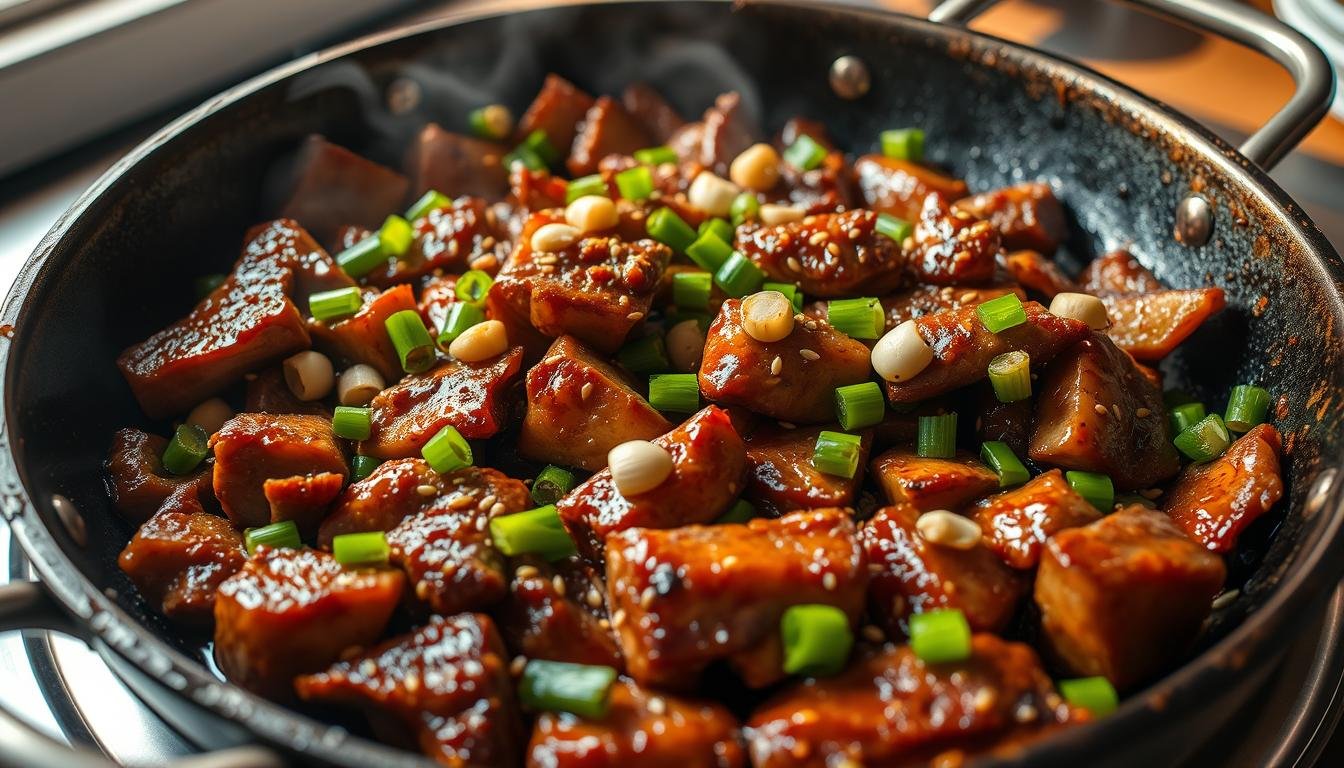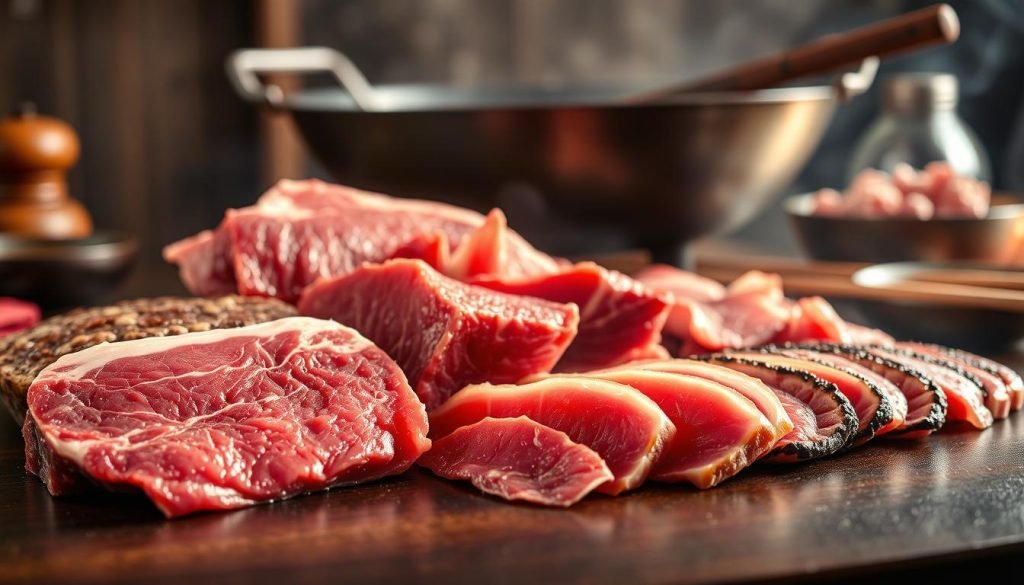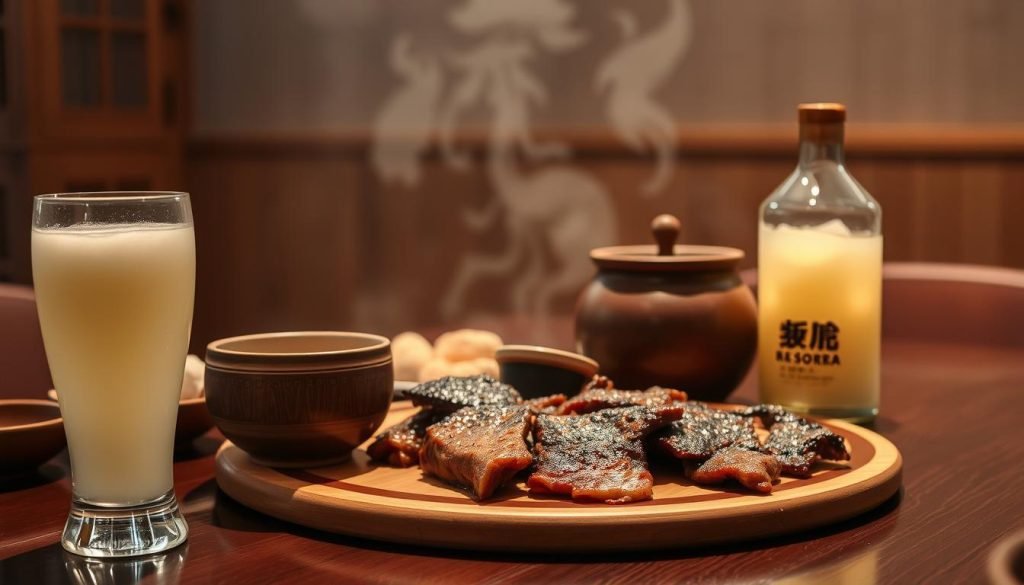Korean Bulgogi Recipe: Easy & Delicious

Have you ever wondered why bulgogi, the cherished dish of Korean BBQ, has captured the hearts and palates of food lovers worldwide? This tantalizing marinated beef dish is not only a staple in Korean cuisine but also an easy dinner option. It brings incredible flavor to your table with minimal effort. Whether you’re hosting a dinner party or looking for a quick weeknight meal, bulgogi satisfies every craving.
In this article, we’ll explore everything you need to know to prepare this delectable dish right at home. With just a few simple ingredients and a short marinating time, you can create an unforgettable experience. This experience rivals your favorite Korean BBQ spot. From choosing the best cuts of meat to perfecting the marinade, we’ll guide you every step of the way.
Let’s dive into the rich history and essential components of bulgogi, a dish that literally means “fire meat” in Korean. Get ready to impress your family and friends with this flavorful delight!
What is Bulgogi?
Bulgogi is a favorite Korean dish. It has flavorful marinated beef, grilled or stir-fried. It tastes sweet and savory, loved by many.
To make bulgogi, beef is thinly sliced. Then, it’s marinated in rich flavors. It’s cooked over high heat for a tasty meal.
A Brief History of Bulgogi
Bulgogi started in the Goguryeo era, from 37 BCE to 668 CE. It’s a big part of Korean food history. Back then, it was meat grilled over charcoal.
Now, bulgogi is found in fancy restaurants and local markets in South Korea. It’s a big part of Korean culture.
Ingredients Used in Bulgogi
Traditional bulgogi uses special ingredients. The main one is beef, like sirloin and ribeye. The marinade has:
- Soy sauce
- White or brown sugar
- Garlic
- Sesame oil
- Onion
- Asian pear
These mix together for a sweet and savory taste. Bulgogi can also have other ingredients or proteins. It’s great with rice and side dishes like kimchi.

The Best Cuts of Meat for Bulgogi
Choosing the right meat is key to making great bulgogi. The best cuts make the dish taste better and feel tender. You can pick from different cuts based on what you like and how you cook. Here are the top beef choices and other proteins for a change.
Choosing the Right Beef
For bulgogi, top sirloin, ribeye, and skirt steak are the best. Each cut has its own special qualities:
- Ribeye: It’s the most loved for its juicy meat.
- Top Sirloin: It’s leaner but still tender and flavorful.
- Skirt Steak: It’s not as tender but works well when marinated thin.
To make the beef tender, cut it thinly against the grain. For thin slices, use less than 1/8 inch for skillet cooking. For grilling, use 1/8 inch. Marinate tougher cuts like flank or skirt steak for at least 2 hours, better overnight.
Alternative Proteins for Bulgogi
Want something other than beef? Here are some great alternatives:
- Pork: Pork shoulder is tasty when marinated and cooked right.
- Chicken: Boneless, skinless chicken thighs soak up flavors well and are a good swap.
- Tofu: Firm tofu is great for a veggie version and holds marinade well.
Marinade is key to bulgogi’s flavor. Choose quality meat, beef or other, for a great Korean BBQ at home.

| Cut of Meat | Tenderness | Marbling | Recommended Marinade Time |
|---|---|---|---|
| Ribeye | High | Excellent | 30 minutes to 24 hours |
| Top Sirloin | Moderate | Good | 30 minutes to 24 hours |
| Skirt Steak | Moderate | Average | 2 hours to overnight |
| Flank Steak | Low | Poor | 2 hours to overnight |
| Pork Shoulder | Moderate | Good | 1 hour to overnight |
| Chicken Thighs | High | Moderate | 30 minutes to overnight |
| Firm Tofu | High | N/A | 30 minutes to 1 hour |
Essential Marinade Ingredients
Creating a flavorful bulgogi starts with the right marinade. This mix adds rich flavors to the meat. It makes every bite juicy and tasty. The main parts are soy sauce, garlic, and sweet elements for balance.
Soy Sauce and its Role
Soy sauce is the heart of the marinade. It adds umami flavor to the beef. Use about 3 tablespoons of soy sauce for every pound of meat.
Korean soy sauce is a good choice. It makes the bulgogi savory and keeps the meat moist while cooking.
Sugar: Balancing the Flavors
Sugar adds sweetness to the marinade. Use light brown sugar or white sugar, about 2 tablespoons per pound of beef. Honey is also great for sweetness and texture.
The sweetness and umami flavors mix well. This creates a taste that is truly Korean.
Other Key Marinade Components
Some ingredients make the marinade even better. Minced garlic adds a strong flavor and smell. Sesame oil brings a nutty taste.
Ginger adds warmth. Gochujang, a Korean chili paste, adds a bit of heat. Optional ingredients like pear or onion puree make the meat tender and sweet.

How to Marinate Bulgogi
Marinating bulgogi makes your meal unforgettable. Let the flavors soak into the beef well. Aim for 1 to 12 hours for the best taste and tenderness. Here are some tips for a great marinating experience.
Recommended Marinating Time
For the best flavor, marinate your bulgogi like this:
- Seafood: at least 20 minutes, maximum 45 minutes
- Chicken and pork: at least 4 hours, up to 6 hours
- Beef: at least 12 hours, up to 24 hours
- Vegetables: at least 20 minutes, up to 24 hours
These times help bring out deep flavors, making the beef taste amazing.
Tips for Effective Marinating
Follow these tips for the best results:
- Thoroughly mix your marinade ingredients before adding the beef. This ensures an even distribution of flavors.
- Slice the beef thinly, ideally to about 1/8-inch thickness. This allows for quick cooking and better absorption of marinade.
- Coat the beef evenly with the marinade. Make sure every piece is thoroughly covered.
- Store your marinated beef in the refrigerator. Keeping it cool allows the flavors to meld while preventing any spoilage.
Cooking Methods for Bulgogi
There are many ways to cook bulgogi. You can grill it outside or stir-fry it quickly. Both ways make the dish delicious. Here’s how to cook it like a pro, making it a tasty dinner.
Grilling Bulgogi at Home
Grilling bulgogi adds smoky flavors and a nice char. Use a charcoal grill for the best taste. Here’s what to do:
- Preheat your grill to medium-high heat.
- Place marinated bulgogi on the grill, ensuring the pieces are not overcrowded.
- Cook for 3 to 5 minutes, flipping once to achieve even caramelization.
- Monitor closely to avoid overcooking, which can lead to a tough texture.
This method makes the meat juicy and flavorful. It’s a treat for your taste buds.
Stir-Frying Bulgogi in a Pan
Stir-frying is quick and easy. Here’s how to do it right:
- Heat a tablespoon of oil in a non-stick skillet over medium-high heat.
- Once hot, add the marinated bulgogi and spread it out in a single layer.
- Cook for about 5 minutes, stirring frequently to ensure even cooking.
- Incorporate vegetables like onions, green onions, or carrots for added nutrition and flavor.
This method is perfect for a fast dinner. It’s a mix of tender beef and crunchy veggies. It’s great for a quick easy dinner.

| Cooking Method | Time Required | Flavor Benefits |
|---|---|---|
| Grilling | 3-5 minutes | Smoky flavor with charred texture |
| Stir-Frying | 5 minutes | Quick meal with juicy, tender beef |
Both methods are great for cooking bulgogi. Choose what fits your schedule. Enjoy this traditional dish at home.
Serving Suggestions for Bulgogi
Serving bulgogi with both traditional and new ideas makes it better. This dish from Korean cuisine is tasty. It needs side dishes that make it even better.
Traditional Accompaniments
Bulgogi is great with Korean side dishes. They add texture and flavor. Here are some good choices:
- Kimchi: It’s tangy and full of good bacteria.
- Steamed Rice: It’s soft and goes well with the beef.
- Japchae: Sweet potato noodles with veggies are a nice contrast.
- Pickled Radish: It’s crunchy and tangy, refreshing your taste buds.
- Brown Rice: A healthy choice, full of fiber.
- Fried Tofu: It’s crispy outside, soft inside, and good for vegetarians.
- Seaweed Salad: A mix of seaweeds in sesame oil, refreshing.
- Stir-Fried Zucchini: With garlic and sesame oil, it’s tasty and healthy.
- Spicy Cucumber Salad: It’s spicy, made with chili paste, garlic, and sugar.
- Korean Potato Salad: Creamy, tangy, with boiled potatoes, veggies, and mayonnaise.
- Marinated Bean Sprouts (Kongnamul): Simple but flavorful.
- Grilled Vegetables: Bell peppers, zucchini, onions, and mushrooms add texture.
Creative Serving Ideas
There are also creative ways to serve bulgogi. Try these:
- Bulgogi rice bowls with fresh veggies and a sunny-side-up egg.
- Bulgogi tacos with spicy kimchi or slaw in soft tortillas.
- Wraps with bulgogi and toppings in lettuce leaves.

Bulgogi Variations Around Korea
Bulgogi is a favorite in Korea, with many regional twists. We’ll look at Jeonju-style and Seoul-style bulgogi. Each has its own flavor and cooking way.
Jeonju-style Bulgogi
Jeonju-style bulgogi uses top-notch beef. The marinade has soy sauce, garlic, and a bit of sweetness. This makes the flavors rich and deep.
| Feature | Jeonju-style Bulgogi |
|---|---|
| Beef Quality | High-quality, local cuts |
| Marinade Strength | Robust and flavorful |
| Serving Style | Traditionally grilled at the table |
| Popularity | Strong local preference |
Seoul-style Bulgogi
Seoul-style bulgogi is quick and popular in the city. It uses hanwoo or imported beef. It’s cooked fast, in 5 to 8 minutes.
| Feature | Seoul-style Bulgogi |
|---|---|
| Cooking Time | 5-8 minutes |
| Beef Options | Hanwoo or imported |
| Flavor Profile | Stew-like with broth |
| Popularity | Common in urban dining |

Bulgogi is loved in Korea, from Jeonju’s grilled taste to Seoul’s quick dish. It shows Korea’s rich food culture. Bulgogi is a favorite, loved for its many flavors and cooking ways.
Tips for a Perfect Bulgogi
To make the best bulgogi, pay close attention to details. Knowing common mistakes helps a lot. Here are some tips to make your bulgogi amazing.
Common Mistakes to Avoid
- Don’t overcrowd the pan. It makes cooking uneven and can stop a good sear.
- Marinate for at least 12 hours. This brings out the flavor.
- Cut the beef thinly, about ⅛-inch. This makes it tender and cooks fast.
- Use high heat to cook. A “screaming hot” pan is best.
Pro Tips for Great Flavor
- Try different marinades. Change soy sauce and sugar to your liking.
- Marinate for at least 30 minutes. But overnight is even better.
- Sear the meat for 1-2 minutes on each side. This gets the best caramelization.
- Add different side dishes, like kimchi. It makes the meal better.

| Marinade Ingredient | Amount |
|---|---|
| Soy Sauce | 1/4 cup (adjust to taste) |
| Brown Sugar | 3 tbsp |
| Granulated Sugar | 1 tbsp |
| Mirin or Matsool | 2.5 tbsp |
| Garlic (finely grated) | 4 large cloves |
| Black Pepper | 1/4 tsp |
| Neutral Cooking Oil | 1 tbsp |
| Sesame Oil | 1 tbsp |
Correct cutting, marinating, and cooking are key for great flavor in bulgogi. Remember these tips for a perfect bulgogi to improve your cooking.
Storing Leftover Bulgogi
After enjoying your delicious bulgogi, it’s important to store leftovers right. This keeps the taste and quality good. When you’re ready to eat it again, reheating it right will make it taste like the first time.
Best Practices for Refrigeration
For storing leftover bulgogi, put it in an airtight container first. This keeps moisture in and smells out. It lets you enjoy it for up to 3-4 days.
Bulgogi can also be frozen for longer. It keeps for about 2 months in the freezer. Make sure it’s cooled down before freezing. This keeps it fresh for longer.
Reheating Bulgogi Safely
There are easy ways to reheat your bulgogi. In the microwave, warm it for 2-3 minutes. Stir every 30-45 seconds to heat evenly.
Or, use a skillet over medium heat. It takes about 5-7 minutes to heat through. Don’t reheat it more than once to keep the taste and texture good.

| Storage Method | Duration |
|---|---|
| Refrigeration (airtight container) | 3-4 days |
| Freezing (airtight container) | Up to 2 months |
Pairing Drinks with Bulgogi
Choosing the right drinks can make bulgogi even better. Korean drinks and wine and beer pairings add to the dish’s taste. Soju or a lager can make your meal special.
Traditional Korean Drinks
Soju is a favorite in Korea, great with beef bulgogi. It’s clear and strong, but easy on the stomach. Makgeolli, a cloudy rice wine, also pairs well.
Wine and Beer Pairing Suggestions
Wine lovers, bulgogi’s sweet taste can match many wines. Try a dry Riesling from Alsace or Washington State. Pinot Gris and Chenin Blanc also pair well.
Reds like Barbera and Mencia are good too. They’re acidic and have low tannin, matching bulgogi’s taste.
Beer fans, light lagers like Hite or OB are good with bulgogi. Drinking alkaline foods like oiseon can add a fun twist.

Conclusion: Enjoying Your Bulgogi
Bulgogi is a favorite in Korean food and around the world. It started as a royal dish but now brings people together. You can make it at home with the right ingredients and cooking methods.
Recap of Key Points
Bulgogi means “fire meat” and is beef marinated and grilled. The marinade, with soy sauce and sugar, makes it tender. Sharing bulgogi shows the joy of Korean food.
Encouragement to Try the Recipe
It’s time to get cooking with bulgogi. You can make it the traditional way or try new recipes like bulgogi tacos. Explore Korean food and enjoy making a dish loved for years!